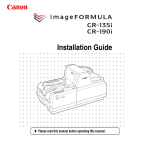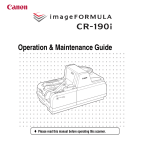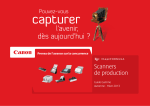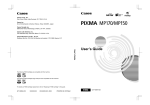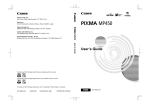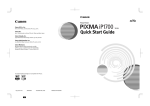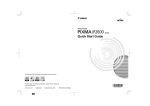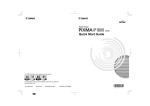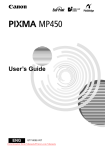Download Canon imageFORMULA CR-190i Installation guide
Transcript
Operation & Maintenance Guide ♦ Please read this manual before operating this scanner. ■ International ENERGY STAR® Office Equipment Program ■ FCC REGULATIONS (For 120V model) As an ENERGY STAR® Partner, CANON ELECTRONICS INC. has determined that this machine meets the ENERGY STAR® Program guidelines for energy efficiency. The International ENERGY STAR® Office Equipment Program is an international program that promotes energy saving through the use of computers and other office equipment. The program backs the development and dissemination of products with functions that effectively reduce energy consumption. It is an open system in which business proprietors can participate voluntarily. The targeted products are office equipment, such as computers, monitors, printers, fax, machine, copiers, and scanners. The standards and logos are uniform among participating nations. Check Reader, Model M111071/M111021 This device complies with Part 15 of the FCC Rules. Operation is subject to the following two conditions: (1) This device may not cause harmful interference, and (2) this device must accept any interference received, including interference that may cause undesired operation. Note: This equipment has been tested and found to comply with the limits for a Class B digital device, pursuant to Part 15 of the FCC Rules. These limits are designed to provide reasonable protection against harmful interference in a residential installation. This equipment generates, uses, and can radiate radio frequency energy and, if not installed and used in accordance with the instructions, may cause harmful interference to radio communications. However, there is no guarantee that interference will not occur in a particular installation. If this equipment does cause harmful interference to radio or television reception, which can be determined by turning the equipment off and on, the user is encouraged to try to correct the interference by one or more of the following measures: - Reorient or relocate the receiving antenna. - Increase the separation between the equipment and receiver. - Connect the equipment into an outlet on a circuit different from that to which the receiver is connected. - Consult the dealer or an experienced radio/TV technician for help. Use of shielded cable is required to comply with class B limits in Subpart B of Part 15 of FCC Rules. Do not make any changes or modifications to the equipment unless otherwise specified in the manual. If such changes or modifications should be made, you could be required to stop operation of the equipment. Canon U.S.A. Inc. One Canon Plaza, Lake Success NY 11042, U.S.A. Tel. No. (516)328-5000 This model doesn’t provide “setting options” for power management. ■ European Union (and EEA) only. This symbol indicates that this product is not to be disposed of with your household waste, according to the WEEE Directive (2002/96/EC) and your national law. This product should be handed over to a designated collection point, e.g., on an authorized one-for-one basis when you buy a new similar product or to an authorized collection site for recycling waste electrical and electronic equipment (EEE). Improper handling of this type of waste could have a possible negative impact on the environment and human health due to potentially hazardous substances that are generally associated with EEE. At the same time, your cooperation in the correct disposal of this product will contribute to the effective usage of natural resources. For more information about where you can drop off your waste equipment for recycling, please contact your local city office, waste authority, approved WEEE scheme or your household waste disposal service. For more information regarding return and recycling of WEEE products, please visit www.canon-europe.com/environment. (EEA: Norway, Iceland and Liechtenstein) ■ RADIO INTERFERENCE REGULATIONS (For 120V models) This digital apparatus does not exceed the Class B limits for radio noise emissions from digital apparatus as set out in the interference-causing equipment standard entitled “Digital Apparatus”, ICES-003 of the Industry Canada. ■ Für EMVG Dieses Produkt ist zum Gebrauch im Wohnbereich, Geschäfts-und Gewerbebereich sowie in Kleinbetrieben vorgesehen. ■ RÈGLEMENT SUR LE BROUILLAGE RADIOÉLECTRIQUE (For 120V models) ■ Model Names The following names may be provided for the safety regulations in each sales region of the Check Reader. CR-135i: Model M111071 CR-190i: Model M111021 Cet appareil numérique respecte les limites de bruits radioélectriques applicables aux appareils numériques de Classe B prescrites dans la norme sur le materiel brouilleur: “Appareils Numériques”, NMB-003 édictée par l’Industrie Canada. 2 ■ Trademarks • Canon and the Canon logo are registered trademarks of Canon Inc. in the United States and may also be trademarks or registered trademarks in other countries. • imageFORMULA is a trademark of CANON ELECTRONICS INC. • Microsoft, Windows, Windows Vista, and Windows 7 are registered trademarks or trademarks of Microsoft Corporation in the United States and other countries. • Microsoft product screen shot(s) reprinted with permission from Microsoft Corporation. • Adobe, Acrobat, and Adobe Reader are registered trademarks or trademarks of Adobe Systems Incorporated in the United States and other countries. • Other product and company names herein are, or may be, the trademarks of their respective owners. • Ranger is a trademark of Silver Bullet technology, Inc. ■ Copyright Copyright 2010 by CANON ELECTRONICS INC. All rights reserved. No part of this publication may be reproduced or transmitted in any form or by any means, electronic or mechanical, including photocopying and recording, or by any information storage or retrieval system without the prior written permission of CANON ELECTRONICS INC. ■ Disclaimers The information in this document is subject to change without notice. CANON ELECTRONICS INC. MAKES NO WARRANTY OF ANY KIND WITH REGARD TO THIS MATERIAL, EITHER EXPRESS OR IMPLIED, EXPECT AS PROVIDED HEREIN, INCLUDING WITHOUT LIMITATION, THEREOF, WARRANTIES AS TO MARKETABILITY, MERCHANTABILITY, FITNESS FOR A PARTICULAR PURPOSE OF USE OR NON-INFRINGEMENT. CANON ELECTRONICS INC. SHALL NOT BE LIABLE FOR ANY DIRECT, INCIDENTAL, OR CONSEQUENTIAL DAMAGES OF ANY NATURE, OR LOSSES OR EXPENSES RESULTING FROM THE USE OF THIS MATERIAL. CANON ELECTRONICS INC. IS NOT LIABLE FOR THE STORAGE AND HANDLING OF DOCUMENTS SCANNED WITH THIS PRODUCT, OR THE STORAGE AND HANDLING OF THE RESULTING SCANNED IMAGE DATA. IF YOU INTEND TO DISCARD THE ORIGINALS OF THE SCANNED DOCUMENTS, YOU ARE RESPONSIBLE FOR INSPECTING THE SCANNED IMAGES AND VERIFYING THAT THE DATA IS INTACT. THE MAXIMUM LIABILITY OF CANON ELECTRONICS INC. UNDER THIS WARRANTY IS LIMITED TO THE PURCHASE PRICE OF THE PRODUCT COVERED BY THE WARRANTY. 3 INTRODUCTION Thank you for purchasing the Canon Check Reader CR-135i/CR-190i. Please read this manual thoroughly before using the machine in order to familiarize yourself with its capabilities, and to make the most of its many functions. Symbols Used in This Manual The following symbols are used in this manual to explain procedures, restrictions, handling precautions, and instructions that should be observed for safety. Manuals for the CR-135i/CR-190i WARNING The following manuals are provided with the CR-135i/CR-190i. Be sure to read these manuals thoroughly before using the scanner. (The Installation Guide and the Operation & Maintenance Guide are extracted from the Instructions.) Electronic manual is stored as a PDF file on the supplied Setup Disc and requires Adobe Reader to open. (You can download Adobe Reader from the Adobe Web site.) Indicates a warning concerning operations that may lead to death or injury to persons if not performed correctly. To use the machine safely, always pay attention to these warnings. CAUTION Indicates a caution concerning operations that may lead to injury to persons, or damage to property if not performed correctly. To use the machine safely, always pay attention to these cautions. Installation Guide (Supplied with the scanner/Electronic Manual) Describes the procedure for setting up the CR-135i/CR-190i for scanning. Set up the CR-135i/CR-190i in accordance with the Installation Guide. For details on the CR-135i/CR-190i, refer to the Instructions (electronic manual). IMPORTANT Indicates operational requirements and restrictions. Be sure to read these items carefully to operate the machine correctly, and avoid damaging the machine. Operation & Maintenance Guide (Supplied with the scanner/ Electronic Manual): This Manual Describes the basic operations for using the CR-135i/CR-190i, troubleshooting, and maintenance. For details on the settings of the CR-135i/CR-190i, refer to the Instructions (electronic manual). NOTE Indicates a clarification of an operation, or contains additional explanations for a procedure. Reading these notes is highly recommended. Instructions (Electronic Manual) Describes how to use the scanner, and includes instructions for configuring the scanner settings, as well as handling, maintenance, and troubleshooting information. 4 Table of Contents INTRODUCTION ................................................................... 4 Manuals for the CR-135i/CR-190i ............................................... 4 Symbols Used in This Manual..................................................... 4 Document Feeding and Scanning...................................... 6 Documents .................................................................................. Document............................................................................... Envelope ................................................................................ Placing Documents ................................................................ Document Feeding and Scanning ............................................... Scan Procedure ..................................................................... 6 6 7 7 8 8 Troubleshooting ................................................................ 10 When the Scanner Is Not Recognized ...................................... Clearing Paper Jams................................................................. Feeding Trouble ........................................................................ When the Scanned Image Is Not Normal.................................. 10 10 12 13 Maintenance....................................................................... 14 Daily Cleaning ........................................................................... Cleaning the Main Unit......................................................... Cleaning the Feed Path ....................................................... Cleaning the Scanning Glass and Rollers............................ Cleaning the Magnetic Heads .............................................. Cleaning the Ink Jet Nozzles................................................ Cleaning with the Cleaning Cards (U.S.A. Only).................. Maintenance.............................................................................. Replacing the Ink Cartridge.................................................. Replacing the ink disposal tank............................................ Replacing the Rollers ........................................................... Adjusting the Separation Roller Gap.................................... 14 14 14 16 19 20 21 22 22 24 26 29 Index ................................................................................... 30 5 Document Feeding and Scanning This chapter describes precautions regarding documents that can be handled on this scanner and scanning operations. • Scanning documents with a rough surface may not feed easily, and may cause friction between the documents, resulting in a feeding error. If this happens, feed the documents one by one. • To avoid paper jams, damage to documents, and a scanner malfunction, do not feed the following types of paper into the scanner. If you want to scan these types of paper, first make a copy, and then scan the copy. Documents This section describes the types of documents that can be used and how to place them. CAUTION Treat the documents carefully. The paper edges may cut your fingers. Document The CR-135i/CR-190i can feed a wide variety of document sizes. The ranges of height and length for a document are: Height : 2.7" to 4.3" (68 to 108 mm) Length : 4.7" to 9.6" (120 to 245 mm) Thickness : 0.003" to 0.008" (0.08 to 0.20 mm) Weight : 17 to 40 lb bond (64 to 157 g/m2) Wrinkled or creased paper Carbon backed paper Curled paper Coated paper or fax recording paper Torn paper Extremely thin paper Paper with clips or staples Paper with binding holes NOTE Length • Note that mixing documents of different thickness may cause a malfunction during feeding. • Curled, wrinkled, or folded documents may cause an error. If this happens, straighten out the curls, or reduce the number of documents loaded. Height Follow these guidelines when you prepare a document for scanning: • Before scanning documents that contain pasted artwork, make sure that the ink or paste is thoroughly dry. If the documents are scanned with wet ink or paste, the inside of the scanner may become dirty and it may cause a malfunction. • If you scan a document written in pencil, the letters may not be scanned properly or the pencil may rub off onto the rollers and stain subsequent documents. Before you scan this kind of document, make a copy, and then scan the copy. After scanning a document written in pencil or some other soft writing material, be sure to clean the scanning rollers. (See “Cleaning the Scanning Glass and Rollers” on p. 16.) • If you scan thin paper in the Duplex mode, the ink printed on the back side may be scanned. If this happens, adjust the scanning density. 6 Envelope • Additional documents can be placed while the machine is scanning. You can also scan the envelope. When using separation OFF mode, you can scan an envelope with thickness up to 0.02" (0.5 mm) or weight up to 111 lb bond (413 g/m2). NOTE • Disable the double feed detection function. (See “Using Ultrasonic Double Feed Detection,” on p. 33 in Instructions.) • If the envelope is not the first document in the batch, it may cause a feeding error or a paper jam. • Some type of envelope may cause a feeding error or a paper jam. Placing Documents Note the following points when placing documents on the scanner. • Place the front of the document toward you. • Do not exceed the Load Limit Mark when placing documents in the document tray. This may cause feeding errors or paper jams. IMPORTANT • Align the documents and set the bottom of the documents level in the document tray. • Do not exceed the Load Limit Mark when placing documents. This may cause double feed error. Load Limit Mark • A maximum of 250 documents can be loaded at one time. • Move the stopper to the edge of the document in the document tray in accordance with the document. Otherwise, this may cause a paper eject error. Stopper 7 3 Document Feeding and Scanning This section describes how to load and scan documents. (CR-190i only) If the documents are not aligned, press the JOG Button. The jogger mechanism can be used to align documents. CAUTION • Avoid wearing loose fitting clothing, dangling jewelry, long ties, or long hair that could become entangled with moving parts, especially the rollers that feed paper through the scanner. If such objects become entangled, immediately disconnect the power plug from the power outlet. • Check the paper stack and remove all clips, staples, pins, or any other type of metal or plastic fastener. These objects may cause damage to the document, a paper jam, or a scanner malfunction. • Do not touch anything except the operation buttons when the jogger is operating (CR-190i only) or documents are being fed. • Do not touch documents that are being fed under any circumstances. The documents that are being fed may cut your hand. IMPORTANT • If you press the JOG Button when a batch of documents of various sizes are loaded, the alignment will be incomplete, and the documents will not be scanned in the order loaded. If you are scanning documents of various sizes, align the leading edges of all the documents with the entry point of feeding. • The jogger mechanism is not available for documents of less than 5.9" (150 mm) in length. Scan Procedure 1 2 Carefully align the edges of the document. Place the first page of the document facing you, and place the leading edge of the document into the scanner. NOTE • The jogger does not work when the shutter is open. It occurs on the following conditions: • The STOP Button is pressed and the scanning stops. • There are documents on the document tray when a paper jam occurs. Remove the documents from the document tray to close the shutter. If the jammed document remains or the Top Cover is removed, the jogger does not work. • The jogger vibrates for 6 seconds, and then stops. Press the JOG Button to stop the jogger. 4 The remaining procedure differs depending on the scanner you are using. For the CR-135i: Proceed to step 4 For the CR-190i: Proceed to step 3 8 Adjust the Eject Stopper in accordance with the document. 5 • When printing with the imprinter, ink may get on the leading edge of the document because the documents are ejected onto the printed surface. Instruct scanning to start from the software application. NOTE • When Using the Accompanying Scanning Utility for CR-135i/ CR-190i: There are three scanning methods as follows. Follow the each instruction. Scan 1 page Click [Scan Page] from the [File] menu. Scan Batch to File a Click [Scan Batch to File] from the [File] menu. b Input the File name, and then click [Save]. c Select Simplex or Duplex, and then click [Start Scanning]. Scan Batch to Printer a Click [Scan Batch to Printer] from the [File] menu. b Select Simplex or Duplex, and then click [Start Scanning]. • You can also start scanning with pressing the START Button. 6 Ink residue Printed text or bitmap (back side) • When Using the Accompanying Scanning Utility for CR-135i/ CR-190i: Scanning is suspended and a message is displayed when the Eject Pocket becomes full of documents. Scanning resumes when the documents are removed from the Eject Pocket (Eject Pocket full detection). Scanning starts. NOTE • If “Sort Method” is set in the software application, the document will be ejected to one of the three Eject Pockets according to the sort methods that have been set. Eject Pocket 3 Flapper Separates documents Eject Pocket 2 Eject Pocket 1 9 Troubleshooting This chapter describes the problems that might occur in the CR-135i/ CR-190i, and how to remedy them. Clearing Paper Jams If paper has jammed, open the Maintenance Cover and remove the jammed paper. When the Scanner Is Not Recognized The following causes and remedies describe why your computer may not recognize the scanner. Cause Remedy Cause Remedy Cause Remedy Cause Remedy Cause Remedy CAUTION • Be careful when you clear a paper jam. You may be injured unexpectedly. For example, the paper edges may cut your fingers, or the document may be damaged. • Remove all jammed sheets of paper. Paper scraps left inside the scanner may cause a paper jam or malfunction. The Scanning Utility is not installed. Install the Scanning Utility before connecting the scanner to the computer. (See “Setting Up the Scanner,” on p. 17 in Instructions.) The scanner is not correctly connected to the computer. Connect the scanner to the computer correctly. (See “Connecting the Scanner to a Computer,” on p. 20 in Instructions.) The USB interface provided as standard with your computer is not compatible with the scanner. Not all USB interfaces provided as standard with personal computers are guaranteed. Contact your local authorized Canon dealer for more detailed information. (See “Checking Your Operating Environment,” on p. 18 in Instructions.) USB cable is not compatible with the scanner. Use the USB cable provided with the scanner. (See “Checking Your Operating Environment,” on p. 18 in Instructions.) USB hub is not compatible with the scanner. Remove the USB hub to use the scanner. (See “Checking Your Operating Environment,” on p. 18 in Instructions.) 1 10 Remove scanned documents from the Eject Pockets. 2 4 Press and hold the START Button. The jammed document is ejected into the Eject Pocket. If the above procedure does not clear the paper jam, perform the following to remove the jammed document. 3 5 6 Pull the Open Button, and pull the Front Maintenance Cover open to the right and left. 11 Press the Open Button, and push the Back Maintenance Cover open to the back. Remove the paper that has jammed. Close the Back Maintenance Cover. 7 Feeding Trouble Close the Front Maintenance Cover in the order shown in the diagram below. If the document is not fed properly or the detection functions do not work properly, remedy the problem by checking the following conditions. Condition Cause and Remedy Condition Cause and Remedy 12 A paper jam has occurred. • Check to make sure that the size and thickness of the document are within the supported range of the scanner, and if the quality of the paper is appropriate. For cautions on handling documents, see “Documents” on p. 6. • Documents with rough surfaces may cause a paper feed error to occur. Scan one sheet at a time in the separation OFF mode. (See “Separation OFF Mode,” on p. 37 in Instructions.) • Dirty or worn rollers inside the scanner may cause a paper jam. Clean the rollers if they are dirty. (See “Cleaning the Scanning Glass and Rollers” on p. 16.) Worn rollers must be replaced. Some rollers are replaceable. (See “Replacing the Rollers” on p. 26.) If the rollers are not replaceable, contact your local authorized Canon dealer or service representative to have the scanner serviced. • The Separation Roller gap is too wide. Adjust the Separation Roller gap. (See “Adjusting the Separation Roller Gap” on p. 29.) A double feed error often occurs. A double feed error may occur when documents with different thicknesses are mixed. If you are using the CR-190i scanner, you can align the documents using the jogger. If the above-mentioned method is not effective or you are using the CR-135i scanner, adjust the Separation Roller gap. (See “Adjusting the Separation Roller Gap” on p. 29.) Condition Cause and Remedy Other Causes Condition Cause and Remedy Other Causes Condition Cause and Remedy MICR characters are not recognized correctly. • The scanner cannot correctly read MICR characters if the magnetic heads are dirty. Clean the MICR magnetic heads. (See “Cleaning the Magnetic Heads” on p. 19.) • If MICR characters cannot be recognized correctly after cleaning the heads, the MICR heads may be worn. Contact your local authorized Canon dealer or service representative to have the scanner serviced. • The MICR text is on the back of the document. Load the side with the MICR characters face up in the document tray. • Some of the MICR characters are scratched or missing. Splattered MICR ink or toner may also be the problem. The imprinter is not printing correctly (missing imprint dots). Ink is clogged in the ink jet nozzle. Clean the ink jet nozzle. Cleaning the ink jet nozzle is recommended before using the CR-135i/CR-190i. (See “Cleaning the Ink Jet Nozzles” on p. 20.) The ink cartridge may be empty. When the Scanned Image Is Not Normal If there is a problem with the scanned image (the image is not sharp or stripes appear), one of the following conditions may be a probable cause. Check the following conditions, and take the appropriate action. The scanning glass or rollers are dirty. If the scanning glass or rollers are dirty, the dirt will appear on the scanned image. Clean the scanning glass and rollers. For details, see “Cleaning the Scanning Glass and Rollers” on p. 16. The scan conditions are inappropriate. If the scan conditions are inappropriate, the scanned image will not be sharp or will appear as dark. Check the brightness and other scanner settings. If the scanned image is blurry or the document has not been scanned at all, the brightness may be set too high. If the scanned image appears dark, the brightness may be set too low. Also, check the settings on the driver and the software application. The driver or application does not run correctly. Documents get dirty when using the imprinter. Ink from the imprinter has been placed on the feed path. Clean the ink off the feed path. (See “Cleaning the Ink Jet Nozzles” on p. 20 and “Cleaning the Feed Path” on p. 14.) If the document cannot be scanned correctly even if the scan conditions are adjusted, the driver or the application may not be functioning correctly. Reinstall the driver or application. For details on how to install the driver, see “Installing the Software,” on p. 19 in Instructions. For details on how to install the application, see the applications instruction manual. Other Causes Even if the computer may be recognizing the scanner correctly, and the driver and the application is installed correctly, scanning may not be performed correctly. If this happens, the interface card is not compatible. Use the recommended interface card. If the above remedies do not rectify the problem, contact your local authorized Canon dealer or service representative to have the scanner serviced. 13 Maintenance Cleaning the Feed Path This chapter describes how to clean and maintain the scanner. If dirt appears on scanned documents, clean the feed path. Clean the feed path regularly. Daily Cleaning 1 To ensure high-quality image scanning, regularly clean your CR-135i/ CR-190i as described below. Pull the Open Button, and pull the Front Maintenance Cover open to the right and left. CAUTION • Before you clean the scanner, turn OFF the scanner and computer, and disconnect the power cord from the power outlet. Otherwise, it may cause an electrical shock. • Never clean the scanner with any kind of organic solvent, such as alcohol, benzene, or paint thinner. This may cause a fire and electrical shock, or cause the exterior of the scanner to disfigure or discolor. • Never spray mild detergent or water directly on the scanning glass. The spray could penetrate below the glass and contaminate the internal light source and lenses. Cleaning the Main Unit IMPORTANT Wipe the scanner with a firmly wrung cloth, moistened slightly with water or mild detergent. Then, wipe off with a clean, dry cloth. If you notice paper dust in the feed path when you open the Maintenance Cover, clean it out with a clean dry cloth or cotton swabs. 2 14 Press the Open Button, and push the Back Maintenance Cover open to the back. 3 5 Wipe the feed path with a firmly wrung cloth, moistened slightly with water or mild detergent. Then, wipe off with a clean, dry cloth. Feed Path 4 Close the Back Maintenance Cover. 15 Close the Front Maintenance Cover in the order shown in the diagram below. Cleaning the Scanning Glass and Rollers 3 If stripes appear on scanned images or if dirt appears on scanned documents, clean the scanning glass and rollers. Clean the scanning glass and rollers regularly. 1 Remove the Top Cover. 4 2 Press the Open Button, and push the Back Maintenance Cover open to the back. Pull the Open Button, and pull the Front Maintenance Cover open to the right and left. IMPORTANT If you notice paper dust in the feed path when you open the Maintenance Cover, clean it out with a clean dry cloth or cotton swabs. 16 Remove the Roller Cover. 5 6 Spin the rollers while wiping them clean with a firmly wrung cloth dampened with water or a mild detergent. Use a clean dry cloth to clean the entire scanning glass. Scanning Glass There are 26 roller positions, as shown in the diagram below. ԫ Ԫ ԩ ԧ Ԩ Ԥ ԥ Ԧ ԣ Ԙ Ԛ ԙ ԟ Ԡ ԡ Ԣ ԛ 7 Ԝ ԝ Ԟ NOTE • Use cotton swabs to clean the rollers in locations that are too narrow for your fingers. • Roller in position c is turned by the roller in position a. Turn the roller in position a to wipe the rollers. • Rollers in positions h, j, and l are turned by the roller in position k.Turn the roller in position k to wipe the rollers. • Rollers in positions u to z are turned by the roller in position m. Turn the roller in position m to wipe the rollers. • Rollers in positions a to c are replaceable. (See “Replacing the Rollers” on p. 26.) 17 Close the Back Maintenance Cover. 8 10 Carefully replace the Top Cover. Close the Front Maintenance Cover in the order shown in the diagram below. IMPORTANT 9 If paper jams and double feeds (two papers being fed at the same time) still occur after cleaning the rollers, the rollers may be worn. The rollers need to be changed. Some rollers are replaceable. (See “Replacing the Rollers” on p. 26.) If the rollers are not replaceable, contact your local authorized Canon dealer or service representative to have the scanner serviced. Replace the Roller Cover. 18 Cleaning the Magnetic Heads 3 If the magnetic heads are dirty, then MICR characters cannot be scanned correctly. Periodically, clean the magnetic heads with a commercially available audio head cleaner. 1 Pull the Open Button, and pull the Front Maintenance Cover open to the right and left. IMPORTANT If you notice paper dust in the feed path when you open the Maintenance Cover, clean it out with a clean dry cloth or cotton swabs. 2 Use a commercially available audio head cleaner to clean the magnetic heads. The magnetic heads are located in the positions shown in the diagram below. Magnetic Heads 19 Close the Front Maintenance Cover in the order shown in the diagram below. Cleaning the Ink Jet Nozzles 4 Ink that collects around the ink jet nozzles may stain your documents or cause the text or bitmap to appears as scratched. Clean the area around the ink jet nozzles periodically. Cleaning the ink jet nozzles is also efficient action when the printed text or bitmap becomes faint. 1 Remove the Top Cover. 2 Remove the ink cartridge. For more information, see “Replacing the Ink Cartridge” on p. 22. 5 For more information, see “Replacing the Ink Cartridge” on p. 22. 3 Set the ink cartridge. Use the Built-in Nozzle Cleaning Pad to remove the ink from around the ink jet nozzles. Swipe the ink cartridge 2 or 3 times on the Built-in Nozzle Cleaning Pad shown in the diagram below. If the text or bitmap still appear faint after this operation, replace the ink cartridge (See “Replacing the Ink Cartridge” on p. 22.) Built-in Nozzle Cleaning Pad 20 Carefully replace the Top Cover. Cleaning with the Cleaning Cards (U.S.A. Only) 4 5 If a black stripe appears on the back-side of scanned images or if dirt appears on the paper documents upon scanning or for preventative measures, we recommend that you clean your Canon CR-Series scanner as needed with a cleaning card. Using a cleaning card will minimize the frequent cleaning as instructed in this manual. Pull the Eject Stopper. Place the cleaning card in the document tray. It is best to perform a cleaning at beginning or end of the day. A cleaning card does not clean the ink jet nozzles, so please remove the ink cartridge and perform a nozzle cleaning (See “Cleaning the Ink Jet Nozzles” on p. 20.) IMPORTANT • This operation is for U.S.A. Cleaning cards are available only in U.S.A. • Contact your local authorized Canon dealer or service representative for the available cleaning card. 1 2 3 6 7 Turn OFF the scanner. Press the START Button to start cleaning. Please repeat steps 5 and 6. A typical cleaning is feeding the cleaning card 3 to 7 times. If the scanner is extremely dirty, you may need to use another cleaning card. Disconnect the scanner and the computer. 8 9 Turn ON the scanner with pressing the START Button and the STOP Button. Turn OFF the scanner. Connect the scanner and the computer. NOTE • You cannot scan the document without the computer. • Allow 1 to 2 minutes for the moisture on the Canon CR-Series scanner from the cleaning card to thoroughly dry before scanning documents. NOTE If the scanner turned ON properly, the power LED continues to flash. 21 1 Maintenance Remove the Top Cover. Make the following adjustments to maintain scanning quality. Replacing the Ink Cartridge The ink cartridge needs to be replaced if the printed text becomes scratchy or faint even if you have cleaned the ink jet nozzle. The ink cartridge is not included with the scanner. Purchase an ink cartridge separately, as shown below. Compatible ink cartridges: Region Canon Ink Cartridge PG-50 Black Canon Ink Cartridge PG-40 Black Europe and Oceania 0616B001 0615B001 Americas 0616B002/0616B005 0615B002/0615B005 Asia 0616B003 0615B003 2 IMPORTANT • These ink cartridges are available for 5 years after production has stopped. • The ink disposal tank must be replaced when the ink cartridge is replaced. • To replace the ink cartridge, turn the scanner OFF before removing the Top Cover. After the ink cartridge is set, replace the Top Cover, and then turn the scanner back ON. • Finish up the unpacked ink cartridge as soon as possible. More frequent cleaning of the ink cartridge is required if long time elapses after unpacking. 22 Squeeze the Print Position Adjustment Lever, and lift it up to the top position. 3 5 Push the ink cartridge backward, and then remove the ink cartridge. Push down the ink cartridge until it clicks into place. IMPORTANT CAUTION Make sure that the ink cartridge is securely in place. Do not touch the ink jet nozzle right after imprinting. The nozzle may be very hot. 4 6 Squeeze the Print Position Adjustment Lever and move it to adjust the print position. Place the ink cartridge shown in the diagram below. Top: 1.92" (48.8 mm) from the bottom edge of the document Bottom: 1.17" (29.6 mm) from the bottom edge of the document CAUTION Do not touch the electrical contact on the carriage. Doing so may cause a malfunction. NOTE Do not use more than one cartridge by rotation. If you do so, applications cannot check the ink level precisely. 23 7 Replacing the ink disposal tank Carefully replace the Top Cover. When the following conditions appear, you have to replace the ink disposal tank according to the following procedure. • When the ink cartridge is replaced. • When clumpy ink appears on the ink disposal tank as shown below. The replacement ink disposal tank is not included with the scanner. Purchase an ink disposal tank, as shown below. Compatible ink disposal tank: 4623B002 1 24 Open the Ink Disposal Tank Pocket. 2 4 Remove the ink disposal tank. Ink Disposal Tank WARNING Do not print without the ink disposal tank. Doing so may cause a malfunction. NOTE • Be careful not to get dirty with ink. • When you discard the ink disposal tank, put it in the plastic bag in the box of the ink disposal tank. 3 Attach the ink disposal tank. 25 Close the Ink Disposal Tank Pocket. Replacing the Rollers 3 When rollers are worn, paper jams and double feeds tend to occur. You can replace the rollers (Pickup Roller, Feed Roller, and Separation Roller) according to the following procedure. The exchange roller kit is not included with the scanner. Purchase an exchange roller kit separately, as shown below. Open the Feed Supporter to the left. Compatible exchange roller kit: 4623B001 1 Remove the Top Cover. Feed Supporter 2 Remove the Roller Cover. 26 4 5 Pinch the Separation Roller at the rim and the fixing lever, and then remove it with pressing the Separation OFF Mode Button. Pinch the Feed Roller at the rim and the fixing lever, and then remove it. Fixing Lever Fixing Lever 6 NOTE Pinch the Pickup Roller at the rim and the fixing lever, and then remove it. If the Separation Roller is not removed easily because of the fixing lever position, turn the Pickup Roller in anticlockwise direction by hand. Fixing Lever NOTE If the Pickup Roller is not removed easily because of the fixing lever position, turn the Pickup Roller by hand. 27 7 9 Attach the Pickup Roller. Attach the Separation Roller with pushing the Separation OFF Mode Button. Align the notch on the roller axis with the hole on the roller. IMPORTANT Push down the roller until it clicks into place. 8 IMPORTANT Push down the roller until it clicks into place. Attach the Feed Roller. Align the notch on the roller axis with the hole on the roller. 10 Close the Feed Supporter to the right. IMPORTANT Push down the roller until it clicks into place. 28 Adjusting the Separation Roller Gap 11 Replace the Roller Cover. If double feed should occur too often, adjust the Separation Roller gap according to the following procedure. 1 Slide the Adjustment Dial Cover to the left. Adjustment Dial Turn the dial to the left to widen the gap, and turn it to the right to narrow the gap. 12 Carefully replace the Top Cover. 2 Adjust the Adjustment Dial. Turn the Adjustment Dial to the right 3 clicks. If documents are not fed after the above operation, turn the Adjustment Dial back to the left 1 click. 3 Slide the Adjustment Dial Cover to the right. 13 Adjust the Adjustment Dial to 5. For more information, see “Adjusting the Separation Roller Gap” on p. 29. CAUTION Do not use the Adjustment Dial any other time except when adjusting the Separation Roller gap. Turning the Adjustment Dial too much may damage the scanner. 29 Index A P Adjusting the Print Position.......................................................... 23 Adjustment Dial ........................................................................... 29 Amount loaded .............................................................................. 7 Print Position Adjustment Lever .................................................. 22 R Rollers ................................................................................... 16, 26 B S Built-in Nozzle Cleaning Pad ....................................................... 20 Scanning Glass ........................................................................... 16 Separates documents.................................................................... 9 C Cleaning Feed path .............................................................................. 14 Main unit................................................................................ 14 Cleaning Card.............................................................................. 21 T Troubleshooting ........................................................................... 10 D Daily Cleaning ............................................................................. 14 Documents .................................................................................... 6 Document................................................................................ 6 Envelope ................................................................................. 7 How to place documents......................................................... 7 E Eject Pocket................................................................................... 9 Eject Stopper ................................................................................. 7 F Feeding Trouble .......................................................................... 12 Flapper .......................................................................................... 9 I Ink Cartridge ................................................................................ 22 Ink Disposal Tank ........................................................................ 25 Ink Jet Nozzle .............................................................................. 20 J JOG Button.................................................................................... 8 L Load Limit Mark ............................................................................. 7 M Magnetic head ............................................................................. 19 Maintenance ................................................................................ 22 N Number of pages loaded ............................................................... 7 30 CANON ELECTRONICS INC. 1248, SHIMOKAGEMORI, CHICHIBU-SHI, SAITAMA 369-1892, JAPAN CANON U.S.A. INC. ONE CANON PLAZA, LAKE SUCCESS, N.Y. 11042, U.S.A. CANON CANADA INC. 6390 DIXIE ROAD, MISSISSAUGA, ONTARIO L5T 1P7, CANADA CANON EUROPA N.V. BOVENKERKERWEG 59-61, P.O.BOX 2262, 1180 EG AMSTELVEEN, THE NETHERLANDS CANON LATIN AMERICA, INC. 703 WATERFORD WAY, SUITE 400 MIAMI, FLORIDA 33126, U.S.A. CANON SINGAPORE PTE. LTD. 1 HARBOUR FRONT AVENUE #04-01, KEPPEL BAY TOWER, SINGAPORE 098632 CANON HONGKONG COMPANY LTD. 19TH FLOOR, THE METROPOLIS TOWER, 10 METROPOLIS DRIVE, HUNGHOM, KOWLOON, HONG KONG. CANON KOREA BUSINESS SOLUTIONS INC. 168-12 SAMSEONG-DONG, GANGNAM-GU, SEOUL, KOREA PUB. CE-IE-796-02 © CANON ELECTRONICS INC. 2010































